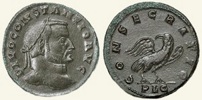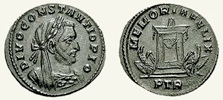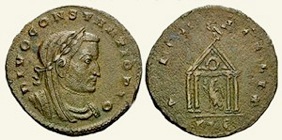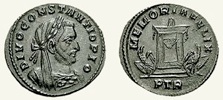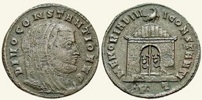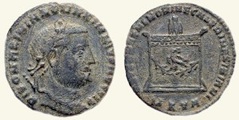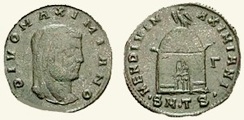Constantius (died 306 AD)
The circumstances of Constantius’ death were recorded (inter alia) in the ‘Origo Constantini Imperatoris’:
-
“... Constantius, after winning a victory over the Picts [in Britain], died at [his palace at] Eboracum [York], and Constantine [his oldest son] was unanimously hailed as Caesar by all [his] troops” (2:4).
Socrates Scholasticus provided the date: 25th July 306 AD (‘Historia Ecclesiastica’, 1.2.1).
Constantius was the first emperor for over a century to die in his bed, with his family around him. However, as Mark Johnson (referenced below, 1992) pointed out:
-
“Beyond the fact that he was honourably buried and [deified], nothing is certain. It would seem most likely that he was buried near one of his residences, perhaps at York but, more probably, near his principal residence at Trier”.
(See also the entry in Mark Johnson’s book of 2009, referenced below, in Appendix B, p 207).
In the page on the Accession of Constantine (306 AD), I hypothesised that:
-
✴Constantine arranged for the cremation of Constantius at York (following the precedent of the burial of Septimius Severus, who had died in the same city in 211 AD);
-
✴Constantius’ ashes were placed in an urn that Constantine took to Trier (again, based on the precedent of Septimius Severus, although, in that case, his sons took his ashes to Rome);
-
✴these remains were interred in a putative mausoleum there (following the precedent of the subsequent burials of Constantius’ imperial colleagues); and
-
✴Constantine then presided over a formal ceremony of deification that involved the incineration of an effigy of Constantius in a multi-storey pyre from which an eagle was released to symbolise his apotheosis (as evidenced by a consecration coin, RIC VI Trier 809, discussed below).
Constantius was the first of the original Tetrarchs to die and thus to test the theory (if there was one) of Tetrarchic deification. As Sabine MacCormack (referenced below, at p 110) pointed out:
-
“...as a result of Diocletian’s reformulation of the position of the emperor in life... consecratio underwent a change that endured: the verdict of humans ceased to matter”.
In other words, Constantius (like all the Tetrarchs) had been chosen by Jupiter, so his access after his death to the councils of the gods no longer required human intervention (i.e. consecration). This concept was expressed in a panegyric (Panegyric VI, translated into English in Nixon and Rodgers, referenced below) that was delivered at the court of Constantine at Trier in 310 AD:
-
“... immediately [after Constantius’ death], the temples of the Gods were opened for him: he was received by the divine conclave and Jupiter himself extended his right hand to him” (7:3).
Mark Johnson (referenced below, 2009, at p 181) spelled out the procedural change that this implied:
-
“No longer was the deceased emperor dependent on either the Senate or his successor for obtaining divine status, though these could and did [sometimes] formalise the process.”
Thus, in formally consecrating his father, Constantine was not claiming to be the agent of his deification. Rather, he was drawing attention to its dynastic ramifications, which the panegyrist (above) also underlined:
-
“What is more, immediately [after he entered into communion with the gods, Constantius] was asked his opinion as to whom he would decree the command [of his army and his part of the Empire], and he spoke as befitted Constantius Pius: for, manifestly, you [Constantine] were chosen by your father’s vote” (7: 3-4).
Galerius, who became the most senior Augustus on the death of Constantius, refused to acknowledge Constantine’s claim to the rank of Augustus, choosing instead to promote Constantius’ erstwhile Caesar, Severus. Galerius never minted for divus Constantius and both Severus and Maximinus (the other imperial colleague) followed his lead. As Bill Leadbetter (referenced below, 2009, at page 166) observed:
-
“By keeping Constantius mortal, [Galerius] denied the rhetorical status of divine descent both to Constantine and to the other children of Constantius”.
In other words, had Galerius recognised Constantine’s consecration of Constantius, he would also have had to concede his claim that divus Constantius was his auctor imperii (i.e. the source of his legitimacy as Augustus). Galerius instead insisted on his own right to decide on Constantine’s status, albeit that he felt obliged to acknowledge the ‘facts on the ground’ by appointing him to the imperial college with the lower rank of Caesar. Thus, an uneasy compromise was reached, at least for the short term.
Constantine’s Coins for Divus Constantius (306-9 AD)
Constantine for DIVO CONSTANTIO AUG: Constantine for DIVO CONSTANTIO PIO:
CONSECRATIO MEMORIA FELIX
RIC VI Lyon 202 RIC VI Trier 789
The OCRE database includes 12 issues by Constantine for divus Constantius at this time. They each had one of the following reverse legends:
-
✴CONSECRATIO: (RIC VI Treveri 809; RIC VI Lugdunum 202; and RIC VI Lugdunum 251); or
-
✴MEMORIA FELIX: (RIC VI Londinium 110; RIC VI Treveri 789-90; and RIC VI Lugdunum 264-9 and 297).
David Sear (referenced below) included additional examples from Lugdunum:
-
✴CONSECRATIO: his entries: 166416 and 16418;and
-
✴MEMORIA FELIX: his entries: 166423 and 16427.
Constantine’s “CONSECRATIO” coins for divus Constantius marked final outing for this traditional reverse legend. The reason for the change has already been discussed: the Tetrarchs had been chosen by the gods, and thus enjoyed automatic access to the gods after death. Their formal consecration was no longer required (although it might be used to shine reflected glory on the consecrator). However, the memory of a divine ancestor now took centre stage, not least because it could be claimed (as Constantine claimed it) as a source of imperial legitimacy bestowed by the gods to an entire dynasty.
CONSECRATIO Coins: Funerary Pyre Reverse
The issue RIC VI Trier 809 has a unique a reverse design that depicted a four-storey funerary structure surmounted by a quadriga (four-wheeled chariot) in which the deceased Emperor sat. This coin is now very rare, but Sabine MacCormack (referenced below, at Plate 35) illustrated an example in the Münzkabinett of the Kunsthistorisches Museum, Vienna.
There is some confusion as to the date of this coin. It was catalogued in RIC as a gold solidus (i.e. a coin type that Constantine introduced in ca. 310 AD to replace the aureus). It has therefore usually been dated to 310-3 AD (a convention followed, for example, by Sabine MacCormack). However, David Sear (referenced below, in the catalogue entry 16414) pointed out that the coin was, in fact, an aureus, and suggested a date of 306-7 AD. If this is correct, this was one of the first coins that Constantine minted for divus Constantius.
The reverse design on this coin seems to have been first used on some of the many CONSECRATIO coins that the Emperor Antoninus Pius (138-61 AD) minted for his beloved wife, Faustina (died 141 AD).
-
✴This interesting page from “Beast Coins” illustrates this design on the reverses of consecration coins minted for:
-
•Antoninus himself;
-
•Marcus Aurelius (161-80 AD);
-
•Lucius Verus (161-9 AD); and
-
•Claudius II (268-70 AD).
-
✴Similar coins (one of which is illustrated in the website of the British Museum) had been minted for Septimius Severus in 211 AD.
-
✴Another interesting example is on a very rare golden aureus (RIC 471, catalogued on the Wildwinds website) that the Emperor Carus (282-3 AD) minted in Rome for his grandson, divus Nigrinianus, who died in infancy during Carus’ brief reign.
As noted above, the most likely scenario is that Constantine minted the divus Constantius coin with this reverse legend and design to commemorate a traditional ceremony of deification that most probably took place at Trier.
CONSECRATIO Coins: Standing Eagle Reverse
The other four CONSECRATIO coins referenced above were all were minted at Lyon (including RIC VI Lyon 202, illustrated above), and all had a reverse design of a standing eagle (sometimes depicted standing on an altar). This was entirely traditional, as is evidenced by the consecration coins minted in the 3rd century:
-
✴by Quintillus and/or Aurelian for divus Claudius II (discussed in the page on Claudius II (268-70 AD));
-
✴by Tetricus for divus Victorinus in Gaul (discussed in the page on the Gallic Empire (260-74 AD)); and
-
✴by Carinus for the divi Carus, Numerianus and Nigrinianus (discussed in the page on Carus, Carinus and Numerian (282-5 AD)).
MEMORIA FELIX Coins
The other twelve issues referenced above had the reverse legend MEMORIA FELIX. Sabine MacCormack (referenced below, at p 112) observed that:
-
“The ‘MEMORIA’ legends are something of a new departure”
They are, in fact absolutely new: the ‘MEMORIAE AETERNAE’ coins for Divus Claudius (RIC V Claudius Gothicus 292-9) that Sabine MacCormack put forward as earlier examples were in fact issued by Constantine, as explained at RIC V:1 p 203.
The reverse design of most of the MEMORIA FELIX coins (10/12, including RIC VI Trier 789, illustrated above) depicted a lighted altar. This was entirely traditional, albeit that it was now coupled to a new reverse legend. Similar coins with the more traditional CONSECRATIO legend had been minted for:
-
✴divus Claudius II (discussed in the page on Claudius II (268-70 AD)); and
-
✴the divi Carus, Numerianus and Nigrinianus (discussed in the page on Carus, Carinus and Numerian (282-5 AD))
Constantine for DIVO CONSTANTIO PIO/ MEMORIA FELIX
RIC VI Lyon 269: Sear 16428
However, the reverse designs of the other two MEMORIA FELIX coins (which were both minted at Lyon) was much more unusual: an eagle standing in a temple. David Sear (referenced below) cataloged them as:
-
✴16427 (not catalogued in RIC), in which the temple had only two columns; and
-
✴16428 (RIC VI Lugdunum 269, illustrated above), which depicted a tetrastyle temple.
These hark back to the coin (RIC III Antoninus Pius 343) that Antoninus Pius had minted for his wife, Faustina, which had a very similar design that represented the six-columned temple identified as “AED DIV FAVSTINAE” (later the Temple of Antoninus and Faustina in the Forum Romanum). However, in this earlier case, the clearly-identified temple contained a cult statue of the seated Faustina.
It is possible that the temples in the divus Constantius coins similarly represented one or more actual cult sites. However, the presence of the standing eagle possibly suggests a more generic interpretation, with:
-
✴the temples symbolising the earthly cult of divus Constantius; and
-
✴the eagle symbolising his apotheosis.
Maxentius’ Coins for Divus Constantius (ca. 307 AD)
DIVO CONSTANTIO AVG/ DIVO CONSTANTIO AVG/
MEMORIA DIVI CONSTANTI MEMORIA DIVI CONSTANTI
RIC VI Aquileia 127 RIC VI Ticinum 97 (307-8 AD)
In 307 AD, the Emperor Maximian, who had returned from retirement to support the rebellion of his son Maxentius in Rome, travelled to Trier to cement an alliance with Constantine against Galerius. As well as giving Constantine his daughter in marriage, Maximian offered him something that Galerius had refused: he elevated him to the rank of Augustus. In the panegyric (Panegyric VII, translated into English by Nixon and Rodgers, referenced below) that was delivered on this occasion, the panegyrist explained that:
-
“... although your father [divus Constantius] had left you imperial power, nevertheless you [Constantine] were content with the title of Caesar and preferred to wait for the man who had declared him Augustus [i.e. Maximian] to so declare you” (5:3).
From this point, the Herculean dynasty of Maximian, Maxentius and Constantine embraced the cult of divus Constantius (see below). (These events are discussed in the page on Maximian's Herculian Dynasty (307-8 AD)).
Following Maxentius’ alliance with Constantine in September 307 AD (mentioned above), he minted the first time for divus Constantius. This series comprised three coins with the reverse legend MEMORIA DIVI CONSTANTI:
-
✴a coin (RIC VI Aquileia 127 ) with a reverse design depicting a lighted altar (illustrated above);
-
✴two coins minted at Ticinum:
-
•one (RIC VI Ticinum 96) that was very similar to the coin above from Aquileia; and
-
•another (RIC VI Ticinum 97, illustrated above) that had a distinctive reverse design of a domed structure with an eagle above (discussed further in the page on Deified Tetrarchs: Mausoleum Coins).
The fact that that Maxentius produced coins for divus Constantius at Aquileia and at Ticinum but not at Rome probably reflects the fact that he had yet to arrange for Constantine’s unilateral deification of his father in 306 AD to be ratified by the Senate.
These coins were expressly dynastic, since the alliance that they commemorated had involved the marriage of Constantine to Fausta, the daughter of Maximian and sister of Maxentius. In Panegyric VII (above), the panegyrist enthused:
-
“[W]hat name can we find that is worthy of this service of yours [Maximian and Constantine] to the State? For you are propagating the State not with plebeian offshoots but with imperial stock [i.e.with the prospective progeny of Constantine and Fausta], so that ... the reins of our common safety ... [will remain in the hands of] Emperors forever Herculian” (2:5).
Maxentius remained part of this dynastic alliance until his break with his father in April 308 AD. Thus, the coins claimed divus Constantius for the Herculian dynasty of Maximian, Maxentius and Constantine.
This alliance ended when Maxentius broke with Maximian in April 308 AD. Maxentius began to mint again for divus Constantius in 311 AD, as described in my page on Maxentius' Consecration Coins (311 AD).
Maximian (died 310 AD)
Maximian was killed following his attempted coup against Constantine in Gaul in 310 AD (described in the page on Constantine in Gaul (308-11 AD)). The circumstances in which he died were described in panegyric (Panegyric VI, translated into English in Nixon and Rodgers, referenced below) that was delivered at Constantine’s court at Trier shortly thereafter. The panegyrist stated that, after Constantine captured him in Marseille in ca. July 310 AD, he allowed him to live, but:
-
“... you [Constantine] cannot accomplish everything: the gods avenge you, even against your will” (20:4).
Earlier in the speech, he had asserted that:
-
“[Maximian] encountered a fate that could not be evaded, one that would bring an unjust end to many men and, finally, a voluntary death to himself” (14:5).
The suggestion seems to be that Constantine had decided to forgive the pathetic and now impotent Maximian, but that he instead had chosen to commit suicide.
Obviously, Constantine would hardly have consecrated Maximian after his rebellion (although, as discussed below, he might well have treated his remains with discreet respect). His fellow Tetrarchs (Galerius, Licinius and Maximinus) were similarly unlikely to have honoured his memory since he had, in effect, also rebelled against them. None of them had any interest in minting consecration coins that acknowledged his apotheosis.
Nevertheless, Maximian was consecrated in time, and quite possibly on two separate occasions:
-
✴by Maxentius, probably following the death of Galerius in April/May 311 AD (as discussed in the page on Maxentius' Consecration Coins (311 AD)); and
-
✴by Constantine, in ca. 317 AD (as discussed in the page on Constantine’s Imperial Cult);
He might even have been buried eventually in the mausoleum that he had built in Milan.
Galerius (died 311 AD)
The page on Galerius II (308-11 AD) describes the circumstances of Galerius’ death in April/May 311 AD. According to the ‘Epitome de Caesaribus’:
-
“[Galerius] was... [then] buried in Dacia Ripensis, [in] a place which he had called Romulianum [Romuliana, modern Gamzigrad, in Serbia] from the name of his mother, Romula” (40:16).
This was the site of what seems to have been Galerius’ planned retirement palace, and the archeological evidence suggests that he was indeed buried in a mausoleum there of which the remains survive (as discussed below).
Bill Leadbetter (referenced below, 2009, at p 242) cited evidence from the so-called ‘Chronograph’ of 354 AD that Galerius had died in Dardania (i.e. not at Romuliana, which, as noted above, was in Dacia Ripensis). He suggested that, when Galerius realised that his end approached, he had attempted a painful journey of some 550 km from his main residence at Thessalonica, but:
-
“Perhaps weakened by his journey, Galerius died en route.”
Licinius had apparently caught up with him by this time, since, according to Lactantius:
-
“Dying, he recommended his wife and son to Licinius, and delivered them over to his hands” (‘De Mortibus Persecutorum’, 35: 3).
Leadbetter (as above) suggested that:
-
“The cortege then moved on to Romuliana. It may well have been Licinius (as was appropriate in the circumstances) who oversaw Galerius’ funeral rites and interment in the mausoleum there.”
Galerius had (probably reluctantly) abandoned the traditional structure of the Tetrarchic college in the year before his death, after which he had ruled as the senior of four Augusti. The other three, in order of seniority (i.e. of their accession dates) were:
-
✴Maximinus;
-
✴Constantine; and
-
✴Licinius.
After Galerius’ death Maximinus and Licinius divided his territories between them. Maximinus, who now ruled the Empire east of the Bosphorus, was formally the senior Augustus (as described in the page on Maximinus, Senior Augustus (311-2 AD)).
Mausoleum and Tumulus of Galerius
It was long thought that Galerius had been buried in what seemed to have been a mausoleum, a rotunda (now the church of Agios Georgio) that formed part of his palace complex there. However, Mark Johnson (referenced below, 2009, at pp 74-6) argued persuasively that neither this nor the so-called ‘Palace Octagon’ had had a funerary function. Instead, as he pointed out (at p 77), the literary sources (as above) were correct:
-
“The mausoleum of Galerius was finally discovered during excavations done in 1989-93 [publishedby Dragoslav Srejovic and Cedomir Vasic (referenced below)]. It is not within the walls of the palace [which had been excavated in 1984] ... but atop a ridge known as Magura, some 1,000 meters to the east of [its] main gate ...]”
This on-line application for the nomination of the whole site as a Unesco World Heritage Site includes a description of this ‘memorial complex’ (described in Section 2B), which stood on the site of a Bronze Age necropolis. A massive tetrapylon at a turn in the road from the palace marked the entrance to the site. The excavations mentioned above had actually uncovered two mausolea on the sacred site beyond it, each of which had an associated circular tumulus. The larger of these mausolea was ascribed to Galerius himself and the smaller and slightly earlier mausoleum was ascribed to his mother, Romula.
Excavation of the two tumuli revealed that each contained (inter alia) the burned remains of wooden structures. Mark Johnson (referenced below, 2009, at p 80) noted that these:
-
“... seem to be in accord with literary descriptions of imperial funerary pyres such as that used in the funeral of Septimius Severus [mentioned above] ... in each case, the pyre was burned before the erection of [the tumulus], which then acted as the memorial to the consecration of Galerius and his mother [Romula] .”
This archeological evidence thus points to the consecration prior to burial of Galerius and his mother. (Galerius had presumably been responsible for the consecration of his mother’s memory. The fact that he never minted for her suggests that this had been a private act of filial piety).
If, as suggested above, Licinius had presided at Galerius’ funeral rites, we must assume that he had formally consecrated his memory (by burning either his body or an effigy in the wooden pyre) before his interment in the mausoleum. Both Licinius and Maximinus minted for divus Galerius (below), but on a restricted scale, while Constantine, the third Augustus refrained completely. Perhaps surprisingly, the largest number of divus Galerius coins was minted by Maxentius.
Maximinus’ Coins for Divus Galerius (ca. 311 AD)
DIVO MAXIMIANO: MAXIMINVS, AVG FIL/
AETERNAE MEMORIAE GALERI MAXIMIANI
RIC VI Cyzicus 75
After Galerius’ death, Maximinus added the mints of Nicomedia and Cyzicus to his original mints at Antioch and Alexandria (see Ian Sellars, referenced below, p 479). He minted for divus Galerius at two of these four mints:
-
✴Alexandria (RIC VI Alexandria: 133; 143; 148; 151; 154; and 159); and
-
✴Cyzicus (RIC VI Cyzicus 75, illustrated above).
All of these coins had a traditional reverse design depicting a funerary altar and the reverse legend ‘AETERNAE MEMORIAE GALERI MAXIMIANI’. (It is interesting to note that this legend was based on one introduced by Maxentius for his consecration coins for divus Romulus in ca. 309 AD).
The coins identified Maximinus as ‘MAXIMINVS AVG FIL’ (i.e. as Galerius’ son). This overtly dynastic claim might well have had substance: Lactantius claimed that Galerius’ widow, Valeria Galeria had rejected Maximinus’ unwanted marriage proposal on the grounds that, inter alia:
-
“... she would not think of marriage while she was in [widow’s] weeds, and while the ashes of Galerius, her husband and, by adoption, the father of [Maximinus], were yet warm” (‘De Mortibus Persecutorum’, 39: 3-5).
However, the small scale of Maximinus’ consecration coinage suggests that he placed much less emphasis on this aspect of his legitimacy than did either Constantine or Maxentius:
-
✴Since the death of Maximian in 310 AD, Constantine had been making a claim or legitimacy in terms of his descent from two consecrated Emperors :
-
-his father, divus Constantius; and
-
-their alleged ancestor, divus Claudius II
-
(evidenced by a panegyric delivered at this court, as discussed in the page on Constantine, Divus Claudius and Sol Invictus).
-
✴Following the death of Galerius, Maxentius had minted enthusiastically for himself as:
-
-son of divus Maximianus;
-
-son-in-law of divus Galerius (who had been his mortal enemy while alive); and
-
-relative of divus Constantius.
-
(as discussed in the page on Maxentius in Rome: (311-2 AD)).
Licinius, the fourth contender for power, unfortunately, had no consecrated ancestors of whom he could boast.
Licinius’ Coins for Divus Galerius (ca. 311 AD)
Licinius for DIVO MAXIMIANO/ MEM DIVI MAXIMIANI
RIC VI Thessalonica 48
After Galerius’ death, Licinus added the mints of Thessalonica and Heraclea to his original mint at Siscia (see Ian Sellars, referenced below, p 531). He minted two coins for divus Galerius:
-
✴a series of coins (RIC Siscia: 205; 206; 220; 221, illustrated in the website Forumancientcoins; 223; 224; and 226), each of which had
-
•an obverse design of the veiled Galerius with the legend DIVO GAL VAL MAXIMIANO [AUG]; and
-
•a reverse design depicting the standing goddess Fortuna and the legend FORTI FORTVNAE ((which was normally a ‘lifetime’ reverse); and
-
✴a coin (RIC VI Thessalonica 48, illustrated above) that had a distinctive reverse design that might have depicted Galerius’ mausoleum (discussed further in the page on Consecrated Tetrarchs: Mausoleum Coins).
It is interesting to note that Licinius made no attempt to use these coins to illuminate his position in Galerius’ Jovian dynasty.
Maxentius’ Coins for Divus Galerius (ca. 311 AD)
Maxentius minted an important series of consecration coins for Galerius as part of his dynastic series (as discussed in the page on Maxentius' Consecration Coins (311 AD)). However, Carol Sutherland (referenced below) catalogued an odd coin (RIC V1 271) minted at Rome that does not belong to this series:
Obverse: DIVO MAXIMIANO AUG: veiled bust of Galerius
Reverse: MEMORIA FELIX: lighted and garlanded altar, flanked by eagles.
The associated note observed that:
-
“[This] reverse type seems to be anomalous for Rome, and the reverse [of the actual coin examined] has been tooled, though not necessarily so as to altar the mark of another mint [i.e. to make a coin that had been minted elsewhere look like it had been minted at Rome].”
If the coin type was as catalogued, it seems that Maxentius had used a precedent from Constantine’s coins for divus Constantius (above) to commemorate the consecration of Galerius. This implies that he moved quickly after Galerius’ death to consecrate his erstwhile enemy, presumably with the approval of the Senate. This was thus a precursor to the dynastic series of coins (below) in which Maxentius explicitly proclaimed himself as Galerius’ heir.
Read more:
‘RIC’ - see Sutherland (1967) below
I. Sellars, “The Monetary System of the Romans: A Description of the Roman Coinage from Early Times to the Reform of Anastasius”, (2013) Google Books
D. Sear, “Roman Coins”, Volume IV (2011) London
M. Johnson, “The Roman Imperial Mausoleum in Late Antiquity”, (2009) Cambridge
W. Leadbetter, “Galerius and the Will of Diocletian”, (2009 ) London
C. E. V. Nixon and B. S. Rodgers, “In Praise of Later Roman Emperors: The Panegyrici Latini”, (1994) Berkeley
D. Srejovic and C. Vasic, “Emperor Galerius' Buildings in Romuliana (Gamzigrad, Eastern Serbia)”, Antiquité Tardive, 2 (1994) 123-41
M. Johnson, “Where were Constantius I and Helena Buried?”, Latomus, 51 (1992) 145-50
S. MacCormack, “Art and Ceremony in Late Antiquity”, (1981) Berkeley
C. H. V. Sutherland, “Roman Imperial Coinage: Volume VI: From Diocletian’s Reform to the Death of Maximinus (294-313 AD)”, (1967, reprinted 1973) London
Galerius as Augustus II (308-11 AD) Licinius (308-11 AD)
Maxentius in Rome: (308-11 AD) Maxentius' Public Works
Maxentius' Complex on Via Appia Maxentius' Coins for Divus Romulus (309 AD)
Constantine in Gaul (308-11 AD) Constantine, Divus Claudius and Sol Invictus
Consecrated Tetrarchs (306-11 AD) Consecrated Tetrarchs: Mausoleum Coins
Literary Sources : Diocletian to Constantine (285-337 AD)
Return to the History Index


